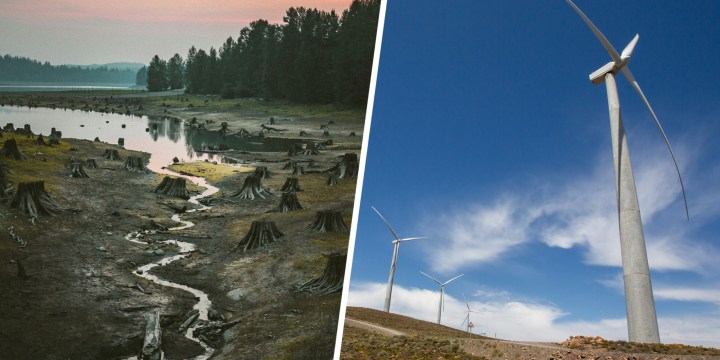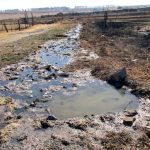SYMBIOTIC CHANGE OP-ED
Balancing biodiversity conservation with the transition to renewable energy

Two of the most significant existential crises facing humanity today are climate change and biodiversity loss. South Africa has made commitments to redress both, but are they compatible and how can we best ensure one does not come at the expense of the other?
South Africa is one of the most biodiverse countries on earth, with diverse ecosystems ranging from the red-soiled deserts on the Namibian border to the humid mangrove forests along our northeastern coastline. This wide array of habitats supports more than 20,000 species, many of which are found nowhere else in the world.
Indeed, just the Kogelberg alone, the Unesco biosphere reserve that fringes the eastern shores of False Bay, contains more species than the entirety of the United Kingdom.
While many of us recognise the intrinsic need to conserve our biodiversity, there are also a multitude of economic benefits to be gained, ranging from the provision of ecosystem goods and services to the vital role biodiversity plays in the country’s tourism industry.
The official government position, as stated in the 2023 White Paper on the Conservation and Sustainable Use of South Africa’s Biodiversity, recognises this with Goal 1 declaring a commitment to enhanced biodiversity conservation.
Furthermore, the country is a signatory of the UN Convention on Biological Diversity which in 2022 adopted the Kunming-Montreal Global Biodiversity Framework.
The framework includes commitments to protect 30% of land, waters and seas by 2030, restore 30% of degraded ecosystems by 2030, and employ urgent management actions to halt species extinctions and manage human-wildlife conflicts.
The long-term shifts in temperatures and weather patterns caused by human-induced climate change alter the ecosystems that support life on Earth.
We are already witnessing the effects in South Africa, with the risk to food and water security, economic development and social cohesion likely to increase should greenhouse gas emissions continue unabated.
A key feature of the Paris Agreement, of which South Africa is a signatory, is the aim to limit the increase in global average temperature to well below 2°C above pre-industrial levels and to pursue efforts to limit the temperature increase to 1.5°C.
Renewable energy
South Africa, however, is the 13th-largest emitter of greenhouse gases globally, due predominantly to its heavy reliance on coal-fired power stations to meet its energy needs. Yet, these needs are not currently being met, with rolling blackouts almost a daily occurrence at great cost to the economy.
Despite reticence from certain government sectors, there is growing acknowledgement of the need to rapidly increase the rollout of renewable energy to help solve the energy shortage and meet our emission reduction commitments.
This is evidenced by the 2019 Integrated Resource Plan which recommended the installation of 20,400MW of wind and solar by 2030 (in the latest draft published for comment last year, this amount has been substantially reduced to 8,183MW, to the chagrin of many).
Moreover, the recently created Presidential Climate Commission has recommended, “close coal faster… and large-scale investment in renewables”.
This is in line with global commitments stemming from COP28 which aims for a trebling of renewable energy capacity by 2030, and the phasing down of coal power.
Natural habitat loss
While climate change is a threat to many species and ecosystems, it is currently dwarfed by the threat of the loss and degradation of natural habitats.
Thus, while conservationists fully support and acknowledge the benefits of shifting to a low-carbon economy fuelled by renewable energy, they are simultaneously concerned about the risk posed by a surge in renewable energy facility-associated infrastructure.
Large solar farms can result in significant habitat loss and fragmentation and disrupt ecosystem processes at the landscape level. Plants and ground-dwelling animals, such as reptiles, small mammals and invertebrates are also particularly vulnerable to the construction of such facilities.
While wind farms can affect the habitat in which they are built, a much larger threat is the one they pose to flying animals, such as birds and bats, due to collisions with the turbine blades. Compounding this threat of collision is the substantial expansion in transmission infrastructure (eg power lines) required to onboard renewable energy facilities to the national grid, with Eskom estimating about 14,000km of transmission lines needing to be constructed by 2032.
The birds most at risk of collisions include charismatic and endangered taxa such as vultures, eagles, bustards, cranes and flamingos. Not only are the collisions with transmission lines fatal for birds, but they can cause substantial disruption to electrical supply and require potentially expensive repairs.
Eskom has long recognised this and in 1996 established a partnership with the Endangered Wildlife Trust working towards mitigating collision risk.
Proactive transition
So how can we support a rapid transition to renewable energy while conserving our biodiversity?
While the environmental impact assessment legislation plays a crucial role in ensuring that developments are conducted in an environmentally responsible way, it is not a panacea and stakeholders across the industry would benefit from a more proactive approach.
This was the motivation behind the creation of Renewable Energy Development Zones; however, while the intention is to be applauded, the resulting zones were created with a broad brush and have come in for criticism.
A project is currently under way to create a national spatial plan that will consider the competing land needs for conservation, renewable energy, and sustainable agriculture.
By incorporating the latest available information products related to threatened species distributions, key biodiversity areas, renewable energy resource maps, current grid capacity and expansion plans, protected area expansion plans and protected agricultural land, we will create an interactive map allowing the prioritisation of land use to best meet the country’s biodiversity, food security and climate change commitments.
Not only do we believe that this level of national-scale spatial planning can mitigate the negative impacts of an expansion of renewable energy facilities, but we also believe there is scope for them to work symbiotically.
Wind farms can be constructed on degraded land and, with appropriate land management, restored to an environment which provides a haven for plants and animals, and in areas with minimal risk to large bird and key bat populations.
OECMs
This touches on the concept of “other effective area-based conservation measures”, or OECMs, which are defined as geographic sites not within a protected area that deliver long-term biodiversity conservation under equitable governance and management.
OECMs can count towards the aforementioned goal of the Convention on Biological Diversity to protect 30% of land, waters and seas by 2030. There is eagerness within the South African conservation sector to explore this potential.
In a similar vein, sustainable agriculture and renewable energy facilities are not mutually exclusive. Wind farms can support grazing cattle or game and, if stocked at appropriate rates, this type of land use is not necessarily incompatible with a healthy, functional ecosystem.
Similarly, agrivoltaics entails the use of the same area of land to both harvest solar energy and agricultural production. The solar panels effectively co-exist with crops or livestock and can benefit plants that need less light or those that can deliver high yields, and provide shade and water to livestock in arid regions.
Agrivoltaic projects have already been rolled out successfully in vineyards in Europe and berry farms in the US and China, and we expect to see accelerated growth in this industry within South Africa.
While we may no longer be at a crossroads, we are not so far down the wrong path that we can’t still find our way back to a sustainable future.
In South Africa, like the rest of the world, this will require a rapid transition to renewable energy.
It is important, however, to carefully consider what long-term impacts this could have on biodiversity.
With careful spatial planning and responsible ground-truthing that uses the best science available to us, we can not only mitigate threats but promote harmonious land use that benefits the planet and all of its inhabitants. DM
Dr Oliver Cowan is a conservation scientist with the Endangered Wildlife Trust.




















 Become an Insider
Become an Insider
Comments - Please login in order to comment.